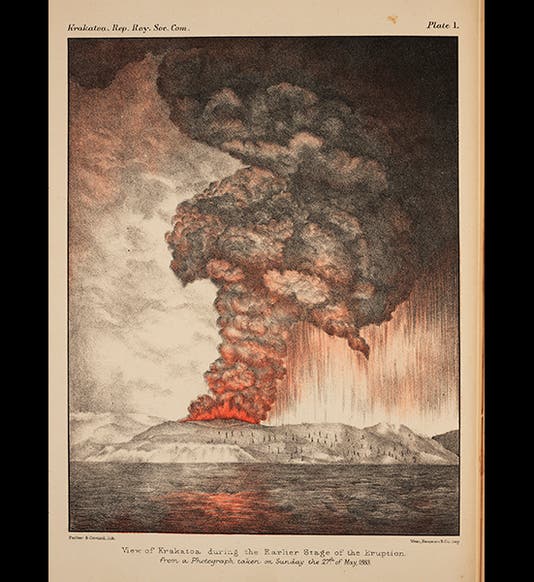Scientist of the Day - Rogier Verbeek


Rogier Verbeek, a Dutch geologist, was born Apr. 7, 1845. On Aug. 27, 1883, Krakatoa, a volcanic island in the Sunda Strait between Java and Sumatra in Indonesia, exploded catastrophically (or, as volcanologists say, paroxysmally). There was no photograph of the final eruption, but we do have one single photograph of the pre-paroxysmal stage in May, rendered into a lithograph (first image above). The eruption of Krakatoa was the most explosive volcanic event of modern times and was exceeded in force only by the eruption of Tambora, at the other end of Java, in 1815. Because of the immense destruction caused by pumice and ash, and three enormous tidal waves, the entire region was in chaos, and since the only means of long distance communication--telegraphy--had been destroyed as well, there was no way to determine from afar what had happened, and what needed to be done. So Verbeek (second image) was sent in with a small team to gather information--from personal observation, from eye-witnesses, from government officials. He spent over a year and a half at the task, and when he was done, he submitted his official report of 550 pages of text, charts, and images to the government of the Dutch East Indies in Batavia (now Djakarta), which they published in 1885 as Krakatau (the Dutch spelling of the volcano). The book is not only the definitive study of the Krakatoa event, but with its detailed records and voluminous amounts of data, it marks the beginning of modern volcanology.
The book was also a graphic success, as it was accompanied by an Atlas, a collection of maps and drawings, as well as an Album of 25 chromolithographs. One of the finest lithographs from the Album is the last one, which shows the part of Krakatoa left standing after the eruption—sliced right down the middle as if by Thor’s mighty hammer (third image). We do not have a copy of Verbeek's Krakatau in our History of Science Collection, despite our best efforts to acquire one.
But we do have a copy of the official publication of the Krakatoa Committee of the Royal Society of London, called The Eruption of Krakatoa (1888), which relies heavily on Verbeek and reproduces some of the superb lithographs from his book (our first image of the erupting volcano comes from the Royal Society work), as well as some marvelous views of sunsets in England after the eruption (fourth image). And we also have a centennial book, published in 1983, and called Krakatau 1883: The Volcanic Eruption and its Effects, ed. by Tom Simkin and Richard S. Fiske (1983). This book devotes 100 of its 440 pages to a translation from the Dutch of the geological sections of Verbeek's Krakatau, evidence that Verbeek's account is still an important collection of information on the eruption. It will be a great future pleasure to add it to our collection someday.
Dr. William B. Ashworth, Jr., Consultant for the History of Science, Linda Hall Library and Associate Professor, Department of History, University of Missouri-Kansas City. Comments or corrections are welcome; please direct to ashworthw@umkc.edu.








